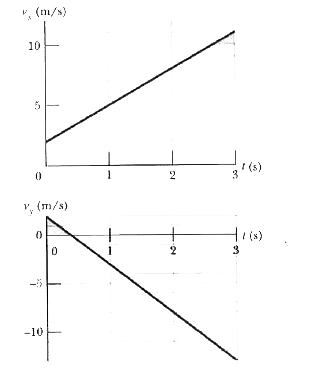Two horizontal forces →F1 and →F2 act on a 4.0 kg disk that slides over frictionless ice, on which an xy coordinate system over frictionless ice, on which an xy coordinate system is laid out. Force →F1 is in the positive direction of the x axis and has a magnitude of 7.0 N. Force →F2 has a magnitude of 9.0 N. Figure 5-39 gives the x component vx of the velocity of the disk as a function of time t during the sliding. What is the angle between the constant directions of forces →F1 and →F2 ?

56∘
Topper's Solved these Questions
- BOOK - RESNICK AND HALLIDAYCHAPTER - FORCE AND MOTION - I EXERCISE - PRACTICE QUESTIONS (Single Correct Choice Type)36videos
FORCE AND MOTION - I
- BOOK - RESNICK AND HALLIDAYCHAPTER - FORCE AND MOTION - I EXERCISE - PRACTICE QUESTIONS (More than One Correct Choice Type)5videos
FORCE AND MOTION - I
- BOOK - RESNICK AND HALLIDAYCHAPTER - FORCE AND MOTION - I EXERCISE - CHECKPOINT5videos
FORCE AND MOTION - I
- BOOK - RESNICK AND HALLIDAYCHAPTER - FLUIDSEXERCISE - PRACTICE QUESTIONS (Integer Type )5videos
FLUIDS
- BOOK - RESNICK AND HALLIDAYCHAPTER - FORCE AND MOTION-IIEXERCISE - PRACTICE QUESTIONS (Integer Type)1videos
FORCE AND MOTION-II
Similar Questions
A constant horizontal force →Fa pushes a 2.00 kg package across a frictionless floor on which an xy coordinate system has been drawn. Figure 5-42 gives the package's x and y velocity components versus time t. What are the (a) magnitude and (b) direction of →Fa ?
 View Solution
View SolutionA coin slides over a frictionless plane and across an xy coordinate system from the origin to a point with xy coordinates ( 3.0 m , 4.0 m) while a constant force acts on it. The force has magnitude 2.5 N and is directed at a counter-clockwise angle of 100∘ from the positive direction of the x axis. How much work is done by the force on the coin during the displacement ?
View Solution
Knowledge Check
- Question 1 - Select One
Two forces −→F1and−→F2 are acting at right angles to each other , find their resultant ?
A√F21−F22B√F21+F22C√(F1+F2)DF1+F2 - Question 2 - Select One
A force →F1 of magnitude 9 N makes an angle of 30∘ with the X-axis. Another force →F2 of magnitude 12 N, makes an angle of 120∘ with the X-axis. What is the magnitude of the resultant force ?
A7.5 NB10 NC12.5 ND15 N - Question 3 - Select One
Two constant forces →F1 and →F2 acts on a body of mass 8 kg. These forces displaces the body from point P(1,−2,3) to Q(2,3,7) in 2s starting from rest. Force →F1 is of magnitude 9 N and is acting along vector (2ˆi−2ˆj+ˆk) . Work done by the force →F2 is :-
A80JB−80JC−180JD180J
Two forces →F1=3ˆi+4ˆj and →F2=3ˆj+4ˆk are acting simultaneously at a point. What is the magnitude of the resultant force ?
View SolutionTwo forces →F1=2ˆi+2ˆjNand→F2=3ˆi+4ˆkN are acting on a particle
(a) Find the resultant force acting on particle
(b) (b) Find the angle between−→F1&−→F2
(c) Find the componant of force −→F1 along force −→F2.View SolutionTwo forces →F1=500N due east and →F2=250N due north have their common initial point. →F2−→F1 is
View SolutionA force →F=4ˆi+ˆk acts through point A (0, 2, 0). Find the moment →m of →F about the point B (4, 0, 4).
View SolutionTwo forces →F1=500N due east and →F2=250N due north have their common initial point. →F2−→F1 is
View Solution

